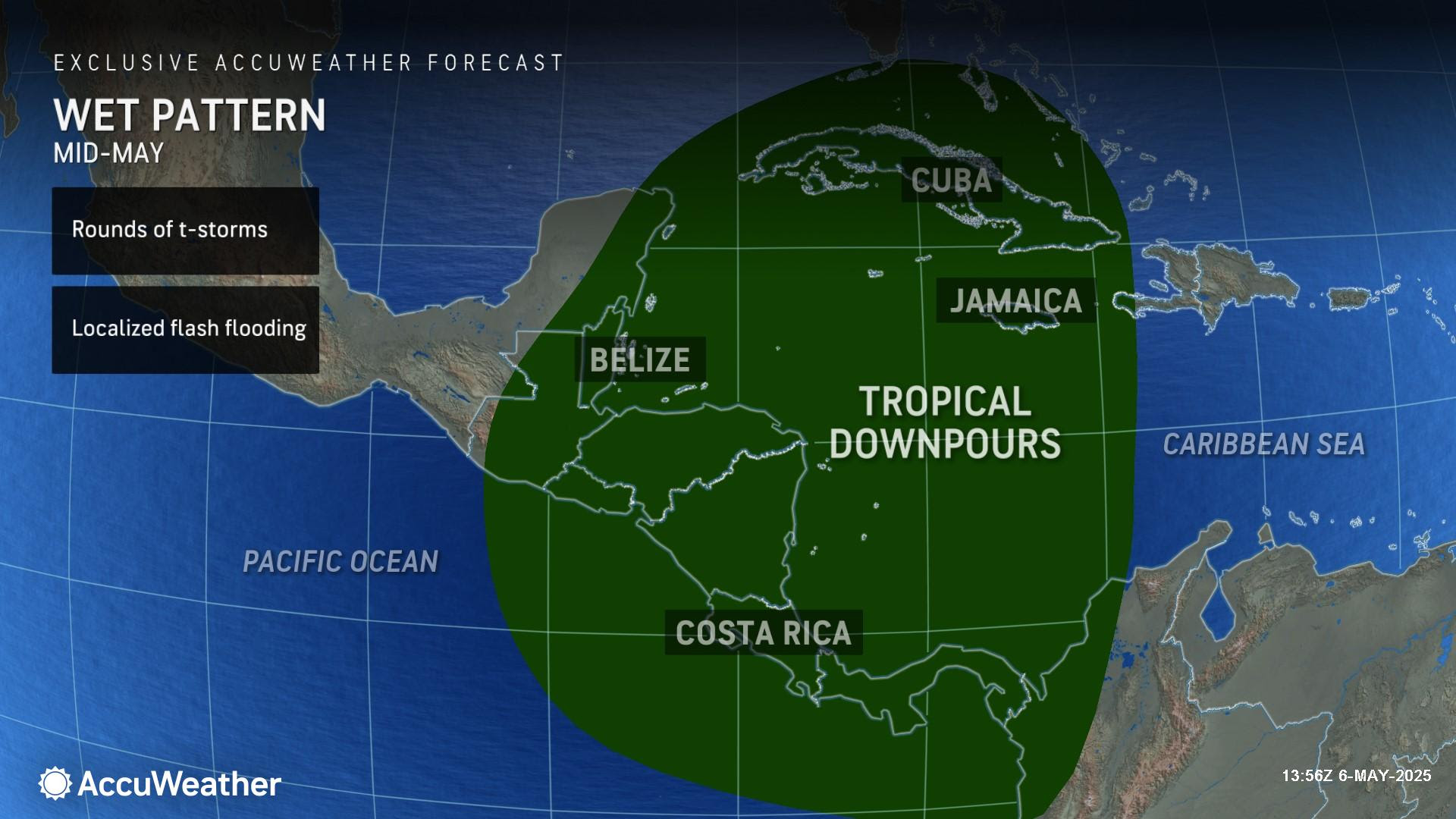
CLICK HERE TO JOIN OUR WHAT’S APP GROUP
AccuWeather Global Weather Center – May 6, 2025 – As leaders and emergency officials across the Gulf Coast and eastern United States urge families and businesses to gear up for the approaching Atlantic hurricane season as part of National Hurricane Preparedness Week, AccuWeather hurricane experts say there is a low risk for preseason tropical development potential in the Caribbean starting later next week.
AccuWeather hurricane experts say there is also a low risk of tropical development potential in the Pacific off the coast of Central America from May 15-22.
A large, slow-spinning area in the atmosphere could develop somewhere around Central America, overlapping with part of the Caribbean and eastern Pacific Ocean around the middle of May.
This phenomenon, known as a gyre, can sometimes lay the groundwork for a tropical depression or tropical storm formation.

“We’re starting to get into that time of year where we need to keep an eye on the Caribbean,” AccuWeather Lead Hurricane Expert Alex DaSilva said. “At the very least, a wetter pattern down across Central America and then up into the Western Caribbean is expected.”
AccuWeather hurricane experts say tropical downpours could cause localized flooding across Central America, Jamaica, Cuba, and other islands across the western Caribbean. Some downpours could also reach South Florida.

“We’re coming out of the winter season, so we want people to start transitioning their mindset into tropical mode as we head toward the end of May, because there could be something lurking down there in the middle to late portions of the month,” DaSilva added.
If the gyre does spawn a tropical depression or tropical storm in the Caribbean, it is likely to track northeastward.
“Given the pattern, I think the most likely scenario is it would cross over Jamaica, Cuba, and then head out to sea,” DaSilva explained. “Right now, while we cannot rule it out, it does not look like a track to toward the U.S. is most likely. Any risk would not be until at least May 20 and likely not until May 22.”
History of tropical trouble in May
While the traditional Atlantic hurricane season starts June 1 and runs through November 30, AccuWeather hurricane experts say it has become more common for tropical storms to develop during the month of May. There have only been four years when a tropical system did not spin up in May since 2015.

Warming water in late spring can set the stage for development, particularly in the Caribbean, eastern Gulf and western Atlantic. Additionally, a slow-moving cold front or a dip in the jet stream could reach far enough south and linger long enough for storms to form in these zones.

Tropical Storm Bertha was the most recent storm to make landfall in the United States in May after it hit South Carolina in 2020. This came less than two weeks after Tropical Storm Arthur made a close swipe along the coast of North Carolina, but the center of the storm never made landfall as it curved out to sea.
What is the gyre?
AccuWeather hurricane experts say a gyre refers to a large, weak area of low pressure and cyclonic, or counterclockwise, circulation that can form over Central America. It’s essentially a broad, slow-spinning area of weather, often associated with the development of tropical systems.

While the Central American gyre itself doesn’t typically become a hurricane, it can provide the conditions for disturbances to develop into tropical depressions, storms, and even hurricanes.
Whether or not a gyre takes shape over Central America in mid-May could hinge on the jet stream.
“Essentially, what’s happening is we’re going to be getting a dip in the jet stream to come down into the southeastern United States during the middle of May,” DaSilva explained.
The question is whether the dip in the jet stream is strong enough and reaches far enough south to initialize the gyre and get it spinning.
DaSilva said that disruptive winds, known as wind shear, or winds changing direction or speed at increasing heights in the atmosphere, could also be lower through much of May, which is another reason why AccuWeather forecasters are monitoring the region for potential tropical development.
A gyre helped with the formation of Tropical Storm Alberto last June, which made landfall along Mexico’s Gulf coast shortly after the middle of the month. A gyre also developed near the western Caribbean in June of 2023, although it did not lead to a named tropical storm formation.
Prepare now for the 2025 Atlantic Hurricane Season
DaSilva is urging families, businesses, government leaders, and emergency officials in areas prone to tropical storm and hurricane impacts to continue preparing now for the fast-approaching hurricane season, which could bring impacts before the official start of the Atlantic hurricane season on June 1.
“Oftentimes, you don’t have the luxury of watching preseason or early-season storms trek across the open Atlantic for days before approaching the U.S. With a setup like this, a tropical system could quickly develop and be at your doorstep in a matter of two or three days,” DaSilva said.
Named storms that receive a rating on the Saffir-Simpson Hurricane Wind Scale typically receive the most attention, but DaSilva warns that unnamed and slower-moving storms can create a higher risk to lives and property compared to some named tropical storms or even Category 1 hurricanes on the Saffir-Simpson Hurricane Wind Scale.
“Preseason and early-season storms often move quite slowly and can produce tremendous amounts of flooding rainfall. Never let your guard down if your area is at risk of tropical impacts from an unnamed storm,” DaSilva warned. “Last year is a reminder of the dangerous and destructive impacts that are possible from unnamed storms. A tropical rainstorm hit the Carolinas last summer. That storm was never named, but it produced enough rainfall to cause substantial damage and led to dangerous swift water rescues. AccuWeather estimates that unnamed storm caused $7 billion in total damage and economic loss.”
Although destructive wind speeds typically receive the most attention during tropical storms and hurricanes, DaSilva says water is the deadliest threat during hurricane season.
“Water is the biggest killer during hurricane season, not the wind. Storm surge, coastal flooding, and inland flooding tragically claimed more than 100 lives across the country last hurricane season,” DaSilva said.
The AccuWeather RealImpact™ Scale for Hurricanes is a powerful tool to help keep families, businesses, government leaders and emergency officials better informed and prepared this hurricane season.
In contrast to the Saffir-Simpson Hurricane Wind Scale, which classifies storms by wind speed only, the AccuWeather RealImpact™ Scale for Hurricanes is based on a broad range of important factors. In order to better communicate a more comprehensive representation of the potential impact of a storm on lives and livelihoods, the scale covers not only wind speed, but also flooding rain, storm surge and economic damage and loss. Some of these hazards, such as inland flooding and storm surge in many storms, result in more deaths and economic loss than wind.
AccuWeather hurricane experts warned in March that early-season and preseason tropical development was possible in the Atlantic basin this year.
The AccuWeather 2025 Atlantic Hurricane Season Forecast predicts 13-18 named storms this year, with 7-10 of those storms expected to strengthen into hurricanes.
Three to five of those storms are predicted to strengthen into major hurricanes, which is a Category 3 hurricane or higher on the Saffir-Simpson Hurricane Wind Scale. Category 3 hurricanes have maximum sustained winds of 111-129 mph.
AccuWeather hurricane experts predict that three to six storms can directly impact the U.S. this year.
Five hurricanes and one unnamed subtropical storm made landfall in the U.S. in 2024.

AccuWeather experts estimate the total damage and economic loss from tropical impacts in the U.S. last year reached an estimated $457 billion to $506 billion.

- July 9 - AccuWeather estimates the total damage and economic loss from Hurricane Beryl in the United States is $28-32 billion
- Aug. 9 – AccuWeather estimates the total damage and economic loss from Hurricane Debby in the United States is $28 billion
- Sept. 12 - AccuWeather estimates the total damage and economic loss from Hurricane Francine in the United States is $9 billion
- Sept. 18 - AccuWeather estimates the total damage and economic loss from an unnamed storm with tropical storm impacts in North Carolina are $7 billion
- Oct. 3 - AccuWeather estimates the total damage and economic loss from Hurricane Helene to be between $225 billion and $250 billion
- Oct. 10 – AccuWeather estimates the total damage and economic loss from Hurricane Milton to be between $160 and $180 billion
CLICK HERE TO JOIN OUR WHAT’S APP GROUP
CLICK HERE TO JOIN OUR WHAT’S APP GROUP
CLICK HERE TO JOIN OUR WHAT’S APP GROUP
CLICK HERE TO JOIN OUR WHAT’S APP GROUP
CLICK HERE TO JOIN OUR WHAT’S APP GROUP
CLICK HERE TO JOIN OUR WHAT’S APP GROUP
CLICK HERE TO JOIN OUR WHAT’S APP GROUP
Advertise with the mоѕt vіѕіtеd nеwѕ ѕіtе іn Antigua!
We offer fully customizable and flexible digital marketing packages.
Contact us at [email protected]


















One of the worst seasons… Hurricane season… I swear. Hurricanes do us some much already
I don’t think Antigua can handle another bad hurricane nh. That would cripple us bad
Everyone please stay prepared as the season approaches.
I hope we dont get one too bad this year
Comments are closed.